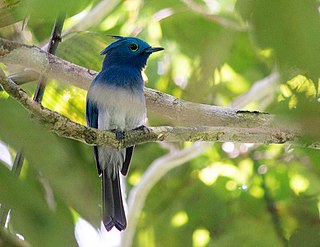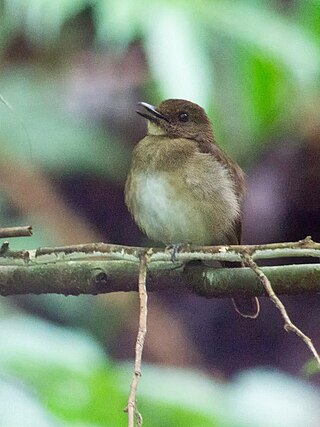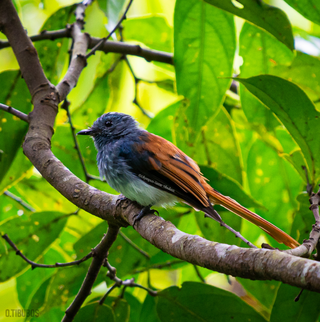
The Apo myna is a species of starling in the starling family Sturnidae. The species is also known as the Mount Apo starling or the Mount Apo king starling. It is the only member of the genus Goodfellowia. It is endemic to the Philippines found only in the tropical montane forests of Mindanao. It is threatened by habitat loss.
The Mindanao brown dove is a threatened species of bird in the family Columbidae. It is endemic to forests on the Philippine islands of Mindanao and Basilan, but it has not been recorded from the latter island since 1937. It is threatened by habitat loss and hunting. Until recently, it was considered conspecific with the Tawitawi brown dove and collectively called the dark-eared brown dove.

The white-winged cuckooshrike, also known as white-winged cicadabird or white-winged graybird, is a species of bird in the family Campephagidae. It is endemic to the Philippines found on the islands of Negros, Panay and formerly on Guimaras. Some taxonomists place this species in the genus Analisoma.
The flame-templed babbler is a species of bird of the family Zosteropidae, in the genus Dasycrotapha. It is one of the most remarkable and distinctive birds with its complex head markings with orange crown tufts, black ears and yellow beak and face. It is endemic to the Philippines, where it is found on the islands of Panay and Negros. Its natural habitat is tropical moist lowland forest. It is threatened by habitat loss. Along with the Negros striped babbler, it is one of the two babbler species extremely sought after by birdwatchers on Negros.

The black-belted flowerpecker or Visayan flowerpecker, is a species of bird in the family Dicaeidae. It is endemic to the Philippines where it is restricted to Panay, Negros and Guimaras islands. It was formerly regarded as a subspecies of the more widespread red-keeled flowerpecker. Sometimes the name red-keeled flowerpecker is used for D. haematostictum and D. australe is then known as the red-sided flowerpecker.

The celestial monarch is a species of bird in the family Monarchidae, and one of the most attractive of all the monarch flycatchers, with its spectacular blue crest and large greenish-yellow wattle. It is endemic to the Philippines with its extant range being in Luzon, Samar, Mindanao Tawi-Tawi and Basilan and it being possibly extinct on Negros and Sibuyan Island. It is often observed in mixed flocks with other birds such as blue fantails, rusty-crowned babblers, rufous paradise flycatchers, both short-crested monarchs and black-naped monarchs and other small forest birds. Its natural habitat is tropical moist lowland forests up to 750 masl. It is one of the most sought after birds by birdwatchers in the Philippines and in the world.
The mountain shrike or grey-capped shrike, is a species of bird in the family Laniidae. It is endemic to the Philippines.

The Mindanao white-eye, also known as the black-masked white-eye, is a species of bird in the family Zosteropidae. The specific epithet honours British zoological collector Walter Goodfellow. It is endemic to the Philippines. Its natural habitat is subtropical or tropical moist montane forest.
The whiskered pitta is a rare species of bird in the family Pittidae. It is endemic to Luzon in the Philippines. This bird is the largest pitta in the country reaching 23 cm long and 116 g in mass. It has a brownish head, blue breast, and red belly. It has broad ash malar or "whiskers". Its natural habitat is tropical moist lowland forest and tropical moist montane forest. It is threatened by habitat loss and trapping. It is one of the most sought after birds by birdwatchers in the Philippines.

The white-throated jungle flycatcher, also known as the Negros jungle flycatcher is a species of bird in the Old World flycatcher family Muscicapidae. It is endemic to the Philippines and formerly on Guimaras before its extirpation there. The natural habitats of the white-throated jungle flycatcher are tropical moist lowland forests and tropical moist montane forests at altitudes of up to 1,350 meters. It is threatened by habitat loss.

The golden-crowned babbler is a species of bird in the family Zosteropidae. It is endemic to the Philippines only being found in the moist tropical forest in Northern Luzon. It is threatened by habitat loss.

The Palawan striped babbler is a species of bird in the family Zosteropidae. It is endemic to the Philippines, where it is only found in Palawan.
The Panay striped babbler is a species of bird in the family Zosteropidae and one of the most attractive birds in the country. It is endemic to the Philippines only being found on the island of Panay (Philippines). Its natural habitat is tropical moist montane forest. It is threatened by habitat loss.

The Luzon striped babbler is a species of bird in the family Zosteropidae. It is endemic to the Philippines, where it is only found in northern Luzon and in Bataan.

The Bicol ground warbler is a species of passerine bird in the family Locustellidae. It is endemic to the island of Luzon in the Philippines, where it is found in the southern parts of the island. Along with its other conspecifics, such as the Cordillera ground warbler and the Sierra Madre ground warbler, it is one of the most elusive birds in the country. Its natural habitat is tropical moist lowland forest. It is threatened by habitat loss.

The Negros scops owl, also known as the Visayan scops owl, is an owl, endemic to the islands of Negros and Panay in the Philippines, belonging to the family of the typical owls Strigidae. It was formerly classified as a subspecies of the Philippine scops owl. It is threatened by habitat loss and hunting for the pet trade.

The yellow-faced flameback is a species of bird in the family Picidae. It is found on the Philippine islands of Negros and Panay. It is extinct on Guimaras, Masbate, and Ticao (extinct). It is one of the most spectacular woodpeckers with its bright yellow head and crimson red back. It is sometimes considered a subspecies of the greater flameback. It is found in moist lowland forests including primary, secondary and even plantations and clearings provided there are still standing trees. It is the rarest woodpecker in the country and it is threatened by habitat loss.

The Visayan fantail is a fantail endemic to the Philippines on islands of Negros, Panay, Guimaras, Masbate and Ticao. Until recently, it was considered conspecific with the blue-headed fantail and Tablas fantail.

The magnificent sunbird is a species of bird in the sunbird family which feed largely on nectar, although they will also take insects, especially when feeding young. Flight is fast and direct on their short wings. Most species can take nectar by hovering like a hummingbird, but usually perch to feed most of the time. It is endemic to the western Philippines found in the Visayan islands of Negros Island, Panay, Cebu, Tablas Island and Romblon. It wasas once considered a subspecies of the crimson sunbird which is found in Borneo, Sumatra and Sulawesi.
The Visayan rhabdornis is a species of bird currently placed in the starling family, Sturnidae. It is endemic to the central Philippines on the islands of Negros and Panay. It was previously considered a subspecies of the stripe-breasted rhabdornis. It lives in tropical moist montane forest and is threatened by habitat loss.














